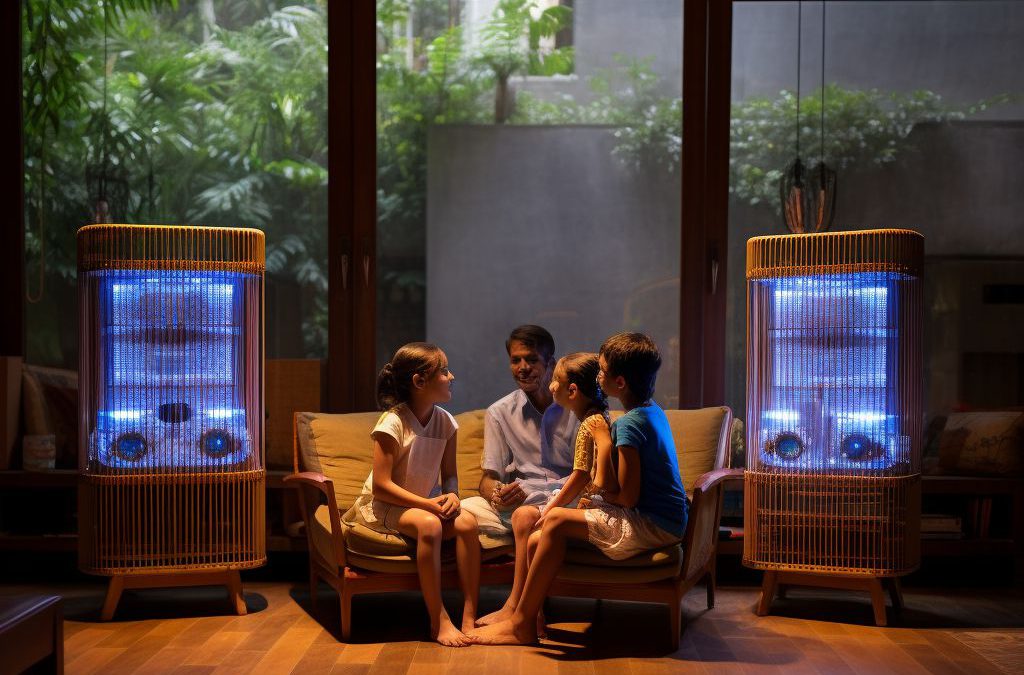Do you feel like there’s a constant humidity in your room? Does the air feel heavy and muggy? If you’ve been wondering about the effectiveness of dehumidifiers and whether they can make your home less stuffy, you’re in the right place. High humidity levels can cause a range of issues from allergies to mold growth, but how do dehumidifiers work and can they actually help? Let’s explore the ins and outs of dehumidification and find out if this appliance is the solution to your stuffy room woes.
Tabe of Contents
- 1. Understanding the Root Cause of “Stuffy” Rooms and How Dehumidifiers Can Help
- 2. How Humidity Affects Air Quality and Your Health at Home
- 3. Benefits of Using Dehumidifiers to Reduce Excess Moisture and Prevent Mold
- 4. Top Considerations When Choosing the Right Dehumidifier for Your Home
- 5. Best Practices for Maintaining Your Dehumidifier to Ensure Optimal Performance and Improve Air Quality
- People Also Ask:
- Final Thoughts:
1. Understanding the Root Cause of “Stuffy” Rooms and How Dehumidifiers Can Help
Have you ever walked into a room and felt as if the air was thick and heavy, making it difficult to breathe? This feeling is often described as a “stuffy” room, and it can be caused by a variety of factors. One of the most common culprits is excess moisture in the air, which can make the air feel damp and heavy.
Excess moisture can be caused by a variety of factors, including poor ventilation, leaks, and high humidity levels. When the air is too humid, it can make it difficult for moisture to evaporate, leading to a buildup of humidity in the air. This can make the air feel heavy and damp, leading to that stuffy feeling.
Fortunately, dehumidifiers can help reduce excess moisture in the air and alleviate that stuffy feeling. By removing moisture from the air, dehumidifiers can improve air quality and make rooms feel more comfortable.
Dehumidifiers work by drawing in moist air and passing it over a cold coil. This causes the moisture in the air to condense, forming water droplets that are then collected in a reservoir tank. The drier air is then released back into the room, helping to reduce humidity levels and improve air quality.
In addition to alleviating stuffy rooms, using a dehumidifier can also help prevent the growth of mold and mildew. These fungi thrive in moist environments, so reducing humidity levels can make it more difficult for them to grow and spread.
So if you’re tired of feeling like you’re breathing in thick, stuffy air, consider investing in a dehumidifier. With its ability to reduce excess moisture and improve air quality, it just might be the solution you’ve been looking for.
2. How Humidity Affects Air Quality and Your Health at Home
Humidity is simply the amount of water vapor present in the air. When there is excess moisture in the air, it can make the atmosphere feel damp and uncomfortable, leading to that “stuffy” feeling in a room. According to the Environmental Protection Agency (EPA), maintaining humidity levels between 30 and 50 percent can help improve indoor air quality and prevent the growth of mold and other harmful microorganisms.
High humidity levels can cause a host of health problems, especially for those who suffer from allergies, asthma, or respiratory conditions. For instance, airborne allergens like pollen, dust mites, and mold thrive in high humidity environments, leading to allergic reactions. Additionally, high humidity can cause discomfort and fatigue, making it difficult to concentrate on tasks and affecting overall productivity.
On the other hand, low humidity levels can cause respiratory irritation, skin problems, and increase the risk of respiratory infections. Inadequate moisture can also cause static electricity, which can damage electronic devices and cause discomfort in people.
By controlling the humidity levels in your home, you can alleviate these issues and improve indoor air quality. Using a dehumidifier is an excellent way to maintain a comfortable indoor environment. It helps remove excess moisture from the air, making it feel cooler and less humid while preventing the growth of harmful organisms like mold and mildew.
3. Benefits of Using Dehumidifiers to Reduce Excess Moisture and Prevent Mold
Dehumidifiers are an essential tool for keeping your home’s air clean and healthy. They work by reducing excess moisture in the air, which can cause a host of problems for both your health and your home. Here are some of the benefits of using a dehumidifier:
1. Reducing Mold and Mildew Growth: Mold and mildew thrive in warm, moist environments, making them common problems in humid regions or areas with poor ventilation. High humidity levels in a home can also lead to water damage, wood rot, and peeling paint. By extracting moisture from the air, a dehumidifier can help prevent these problems and protect your home’s structural integrity.
2. Improving Air Quality: Excess moisture in the air can aggravate allergies, asthma, and other respiratory problems. By removing moisture, a dehumidifier can help reduce symptoms such as coughing, sneezing, and wheezing. Clean, dry air is also essential for protecting the health of your family and pets.
3. Enhancing Comfort and Energy Efficiency: Humid air feels much warmer than dry air, even at the same temperature. This can lead to discomfort and higher energy bills, as your air conditioning system has to work harder to cool your home. By removing excess moisture, a dehumidifier can help keep your home cooler, more comfortable, and more energy-efficient.
Whether you live in a humid climate or simply want to ensure optimal air quality in your home, a dehumidifier can be a simple and effective solution. By reducing moisture and preventing mold and mildew growth, improving air quality, and enhancing comfort and energy efficiency, a dehumidifier can help you breathe easier and enjoy a healthier, more comfortable home.
4. Top Considerations When Choosing the Right Dehumidifier for Your Home
Dehumidifiers are undoubtedly effective in reducing excess moisture and preventing mold in your home, but selecting the right one could be challenging. To guarantee optimal functionality and efficiency, homeowners should consider several factors before making a purchase.
1. Size and Capacity: The size of your dehumidifier will determine the amount of moisture it can extract from your air. Therefore, it’s essential to determine the size of your space and the level of humidity to know the appropriate capacity of the dehumidifier. A small room with low humidity levels might require a unit with a smaller capacity compared to a larger area with high humidity.
2. Features and Operation: Dehumidifiers are equipped with various features, including auto shut-off, digital controls, programmable settings, and adjustable fan speed, among others. Look for a unit with features that best suit your preference and needs. Moreover, ensure that the unit is easy to operate and maintain.
3. Energy Efficiency: Like with most appliances, dehumidifiers consume energy. However, an energy-efficient unit might help you save more money in the long run. Check for the Energy Star rating label, which shows the level of efficiency of the unit. This rating indicates that the dehumidifier uses less energy than other models.
4. Noise Level: Dehumidifiers make noise when they operate, but some produce more noise than others. If you’re planning to place the unit in your bedroom, consider a model with a lower noise level. Ensure that you check the decibel (dB) level indicated on the label or descriptions.
In Conclusion
Choosing the right dehumidifier for your home might seem like a daunting task, but with the above considerations, you’re guaranteed to make an informed decision. Don’t skimp on quality and remember to maintain and clean your unit regularly to ensure optimal performance.
5. Best Practices for Maintaining Your Dehumidifier to Ensure Optimal Performance and Improve Air Quality
.
When it comes to dehumidifiers, regular maintenance is crucial for ensuring optimal performance and improving air quality at home. In this section, we will discuss some best practices for maintaining your dehumidifier.
Clean the Filter Regularly
One of the most important things you can do to keep your dehumidifier running smoothly is to clean the filter regularly. Over time, the filter can become clogged with dust and debris, which can affect the machine’s ability to remove moisture from the air. To clean the filter, simply remove it from the dehumidifier and rinse it under running water. Let it air dry completely before putting it back in the unit.
Empty the Water Tank Daily
The water tank of a dehumidifier is designed to collect the moisture removed from the air. It’s crucial to empty the water tank daily to prevent the buildup of mold and bacteria in the tank. When emptying the tank, be sure to do it over a sink to avoid spills. It’s also a good idea to clean the tank once a week with a mild detergent to prevent the growth of bacteria.
Keep the Unit in a Cool and Dry Place
To ensure optimal performance, it’s important to keep your dehumidifier in a cool and dry place. Avoid storing it in a humid or damp area, as this can reduce the effectiveness of the machine. Additionally, keep the unit away from heat sources, such as radiators or direct sunlight.
By following these simple maintenance practices, you can ensure your dehumidifier is running at its best, removing excess moisture from the air and improving air quality in your home.
People Also Ask:
Why does a room feel stuffy?
A room may feel stuffy due to high humidity levels, inadequate ventilation, and poor air circulation. The presence of dust, pet dander, and other indoor air pollutants can also contribute to a stuffy feeling.
How do dehumidifiers work?
Dehumidifiers work by extracting moisture from the air, which reduces the humidity level in a room. They use a fan to draw humid air into the unit, where the moisture is condensed and collected in a reservoir or drained through a hose.
Can dehumidifiers reduce allergens in the air?
Yes, dehumidifiers can help reduce allergens such as mold, dust mites, and mildew. These allergens thrive in humid environments, so reducing the humidity levels with a dehumidifier can make the air in the room less hospitable to these allergens.
What are the benefits of using a dehumidifier?
Using a dehumidifier can provide several benefits, including reducing humidity levels, eliminating musty odors, preventing mold and mildew growth, improving indoor air quality, and increasing the effectiveness of air conditioning.
What size dehumidifier do I need for my room?
The size of dehumidifier you need depends on the size of the room and the level of humidity. As a general rule, for rooms up to 1,000 square feet, a 30-pint dehumidifier is sufficient. Larger rooms or spaces with higher humidity levels may require a larger unit.
Final Thoughts:
A dehumidifier can help make a room less stuffy by reducing humidity levels and improving air quality, which can have several health benefits. It is important to choose the right size dehumidifier and maintain it properly to ensure it works effectively.

Senior AC Consultant
Jackson’s wealth of knowledge in air conditioning units assists clients in selecting the most suitable systems. His guidance ensures optimal cooling solutions tailored to specific needs.

